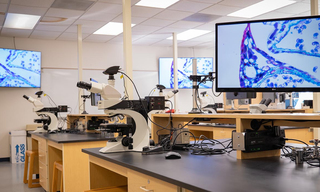Oregon’s Willamette University Graduate-Level Research by Undergraduates, using Lumencor Light Engines
Excerpts from a Willamette University article, originally written by Jennifer Johnson:
A suite of state-of-the-art Leica microscopes outfitted with Lumencor Light Engines are making the invisible, visible for Willamette University students in Olin Science Center. Graduate-level research is being conducted under the supervision of Associate Professor of Biology Jason Duncan in Salem, an hour’s drive from Beaverton, Oregon where Lumencor’s products are manufactured.
What at first appears to be a magnified pill is the embryo of a fruit fly, only a few hours old — the blue lines highlight the distinct pattern of a gene’s expression. The embryo, carefully stained and mounted on a microscope slide by biology major Eleanor McDonough, is visible on a Leica DM2500 compound microscope, one of several within a new microscopy classroom in the Department of Biology. In an epifluorescence modality, students observe structures within a cell. Engineered proteins emit fluorescent light, generating an array of colors that highlight intracellular structures and organisms. Under the right combination of wavelengths, fibroblast cells — the long, thin cells responsible for the stretchiness in skin — reveal glowing blue nuclei, red mitochondria and green microfilaments.
Microscopy sits at the intersection of many disciplines. Understanding the optics of light and how it interacts with a specimen touches on physics, while observing and imaging specimens stained with fluorescent dyes requires a knowledge of chemistry. Analyzing a digital image, composed of millions of pixels, requires a grounding in data science.
“Viewing the world through a microscope is also a pretty cool way to explore it,” stated Duncan. Lumencor is a proud supporter of Duncan, his students and all those who choose to explore at Willamette University.




